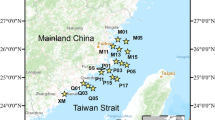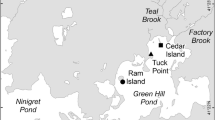Abstract
We measured sediment properties and the abundance and aerobic metabolism of microbes in Willapa Bay, Washington, USA, to test the response of sediment microbes to oyster aquaculture. Sites spanned the estuary gradient (practical salinity units ranged from 24 to 30 under seasonally low river flows) and six different low-intertidal habitat types: eelgrass (Zostera marina), unstructured tideflat, oyster hummocks (reefs of Crassostrea gigas), longline oyster aquaculture, hand-picked on-bottom oyster aquaculture, and dredged on-bottom oyster aquaculture. Aerobic metabolism was assessed by sole-source carbon use (SSCU) of 31 carbon sources on Biolog plates. Sediments generally became siltier and more organically enriched into the estuary, but no consistent differences in sediment properties occurred across habitat types. Bacterial cell density tracked organic content. Across the estuary gradient, overall aerobic SSCU increased less steeply than bacterial cell density, possibly as anaerobic metabolism became more important. Across habitats, aerobic SSCU differed significantly in both overall metabolism and diversity of carbon sources. Aerobic metabolism was generally lower for sediment microbes from intertidal on-bottom oyster aquaculture than from eelgrass. Humans indirectly alter microbial activity through biogenic habitats created during aquaculture, but, as has been shown for bivalves more generally, these changes were relatively small, particularly in comparison to sediment changes along estuarine gradients.




Similar content being viewed by others
References
Bayne, B. L. & A. J. S. Hawkins, 1992. Ecological and physiological aspects of herbivory in benthic suspension-feeding molluscs. In John, D. M., S. J. Hawkins & J. H. Price (eds), Plant-animal Interactions in the Marine Benthos. Systematics Association Special Vol 46. 265–288.
Blum, L. K., M. S. Roberts, J. L. Garland & A. L. Mills, 2004. Distribution of microbial communities associated with the dominant high marsh plants and sediments of the United States east coast. Microbial Ecology 48: 375–388.
Borde, A. B., R. M. Thom, S. Rumrill & L. M. Miller, 2003. Geospatial habitat change analysis in Pacific Northwest coastal estuaries. Estuaries 26: 1104–1116.
Braker, G., H. L. Ayala-del-Rio, A. H. Devol, A. Fesefeldt & J. M. Tiedje, 2001. Community structure of denitrifiers, Bacteria, and Archaea along redox gradients in Pacific Northwest marine sediments by terminal restriction fragment length polymorphism analysis of amplified nitrite reductase (nirS) and 16S rRNA genes. Applied and Environmental Microbiology 67: 1893–1901.
Caruso, G., L. Genovese, M. Mancuso & A. Modica, 2003. Effects of fish farming on microbial enzyme activities and densities: comparison between three Mediterranean sites. Letters in Applied Microbiology 37: 324–328.
Cifuentes, A., J. Anton, S. Benlloch, A. Donnelly, R. A. Herbert & F. Rodriguez-Valera, 2000. Prokaryotic diversity in Zostera noltii-colonized marine sediments. Applied and Environmental Microbiology 66: 1715–1719.
Danovaro, R., C. Gambi, G. M. Luna & S. Mirto, 2004. Sustainable impact of mussel farming in the Adriatic Sea (Mediterranean Sea): evidence from biochemical, microbial and meiofaunal indicators. Marine Pollution Bulletin 49: 325–333.
Dell’Anno, A., M. L. Mei, C. Ianni & R. Danovaro, 2003. Impact of bioavailable heavy metals on bacterial activities in coastal marine sediments. World Journal of Microbiology and Biotechnology 19: 93–100.
Deslous-Paoli, J. M., A. M. Lannou, P. Geairon, S. Bougrier, O. Raillard & M. Heral, 1992. Effects of the feeding behaviour of Crassostrea gigas (bivalve molluscs) on biosedimentation of natural particulate matter. Hydrobiologia 231: 85–91.
Donnelly, A. P. & R. A. Herbert, 1999. Bacterial interactions in the rhizosphere of seagrass communities in shallow coastal lagoons. Journal of Applied Microbiology 85: 151S–160S.
Ferraro, S. P. & F. A. Cole, 2004. Optimal benthic macrofaunal sampling protocol for detecting differences among four habitats in Willapa Bay, Washington, USA. Estuaries 27: 1014–1025.
Fry, J. C., 1982. Interactions between bacteria and benthic invertebrates. In Holmes, D. B. & C. M. Brown (eds), Sediment Microbiology. Academic Press, London: 171–201.
Garland, J. L. & A. L. Mills, 1991. Classification and characterization of heterotrophic microbial communities on the basis of patterns of community-level sole-carbon-source utilization. Applied and Environmental Microbiology 57: 2351–2359.
Gotelli, N. J. & A. M. Ellison, 2004. A Primer of Ecological Statistics. Sinauer, Sunderland MA.
Gray, J. S., 1981. The Ecology of Marine Sediments. Cambridge University Press, Cambridge UK.
Hahn, D. R., 2003. Alteration of microbial community composition and changes in decomposition associated with an invasive intertidal macrophyte. Biological Invasions 5: 45–51.
Hatcher, A., J. Grant & B. Schofield, 1994. Effects of suspended mussel culture (Mytilus spp.) on sedimentation, benthic respiration and sediment nutrient dynamics in a coastal bay. Marine Ecology Progress Series 115: 219–235.
Hickey, B. M. & N. S. Banas, 2003. Oceanography of the U.S. Pacific Northwest coastal ocean and estuaries with application to coastal ecology. Estuaries 26: 1010–1031.
Horner-Devine, C. M., K. M. Carney & B. J. M. Bohannon, 2004. An ecological perspective on bacterial biodiversity. Proceedings of the Royal Society of London Series B 271: 113–122.
Jensen, S. I., M. Kuhl, R. N. Glud, L. B. Jorgensen & A. Prieme, 2005. Oxic microzones and radial oxygen loss from roots of Zostera marina. Marine Ecology Progress Series 293: 49–58.
Kaspar, H. F., P. A. Gillespie, I. C. Boyer & A. L. MacKenzie, 1985. Effects of mussel aquaculture on the nitrogen cycle and benthic communities in Kenepuru Sound, Marlborough Sounds, New Zealand. Marine Biology 85: 127–136.
Kautsky, N. & S. Evans, 1987. Role of biodeposition by Mytilus edulis in the circulation of matter and nutrients in a Baltic coastal ecosystem. Marine Ecology Progress Series 38: 201–212.
Koretsky, C. M., P. Van Cappellen, T. J. DiChristina, J. E. Kostka, K. L. Lowe, C. M. Moore, A. N. Roychoudhury & E. Viollier, 2005. Salt marsh pore water geochemistry does not correlate with microbial community structure. Estuarine Coastal and Shelf Science 62: 233–251.
Koster, M., S. Dahlke & L. A. Meyer-Reil, 2005. Microbial colonization and activity in relation to organic carbon in sediments of hypertrophic coastal waters (Nordrugensche Bodden, Southern Baltic Sea). Aquatic Microbial Ecology 39: 69–83.
Madsen, J. D., P. A. Chambers, W. F. James, E. W. Koch & D. F. Westlake, 2001. The interaction between water movement, sediment dynamics and submersed macrophytes. Hydrobiologia 444: 71–84.
Meyer-Reil, L. A. & M. Koster, 2000. Eutrophication of marine waters: Effects on benthic microbial communities. Marine Pollution Bulletin 41: 255–263.
Newell, R. I. E., 2004. Ecosystem influences of natural and cultivated populations of suspension-feeding bivalve molluscs: A review. Journal of Shellfish Research 23: 51–61.
Newell, R. I. E., J. C. Cornwell & M. S. Owens, 2002. Influence of simulated bivalve biodeposition and microphytobenthos on sediment nitrogen dynamics, a laboratory study. Limnology and Oceanography 47: 1367–1379.
O’Donohue, M. J. D., D. J. W. Moriary & J. C. McRae, 1991. Nitrogen fixation in the sediments and rhizosphere of the seagrass Zostera capricornii. Microbial Ecology 22: 53–64.
Paerl, H. W., J. Dyble, L. Twomey, J. L. Pinckney, J. Nelson & L. Kerkhof, 2002. Characterizing man-made and natural modifications of microbial diversity and activity in coastal ecosystems. Antonie Van Leeuwenhoek International Journal of General and Molecular Microbiology 81: 487–507.
Porter, K. & Y. S. Feig, 1980. The use of DAPI for identifying and counting aquatic microflora. Limnology and Oceanography 25: 943–948.
Purdy, K. J., T. M. Embley & D. B. Nedwell, 2002a. The distribution and activity of sulphate reducing bacteria in estuarine and coastal marine sediments. Antonie van Leeuwenhoek International Journal of General and Molecular Microbiology 81: 181–187.
Purdy, K. J., M. A. Munson, D. B. Nedwell & T. M. Embley, 2002b. Comparison of the molecular diversity of the methanogenic community at the brackish and marine ends of a UK estuary. FEMS Microbiology Ecology 39: 17–21.
Pusceddu, A., G. Sara, M. Armeni, M. Fabiano & A. Mazzola, 1999. Seasonal and spatial changes in the sediment organic matter of a semi-enclosed marine system (W-Mediterranean Sea). Hydrobiologia 397: 59–70.
Rajendran, N., H. Yoshinouchi & O. Matsuda, 1999. Short-term changes in sedimentary microbial communities from coastal aquaculture areas. Fisheries Science 65: 57–62.
Ren, J. S. & A. H. Ross, 2001. A dynamic energy budget model of the Pacific oyster Crassostrea gigas. Ecological Modelling 142: 105–120.
Riese, K., 1985. Tidal Flat Ecology. Springer, Berlin.
Rodhouse, P. G. & C. M. Roden, 1987. Carbon budget for a coastal inlet in relation to intensive cultivation of suspension-feeding bivalve molluscs. Marine Ecology Progress Series 36: 225–236.
Ruesink, J. L., G. C. Roegner, B. R. Dumbauld, J. A. Newton & D. A. Armstrong, 2003. Contributions of coastal and watershed energy sources to secondary production in a northeastern Pacific estuary. Estuaries 26: 1079–1093.
Ruesink, J. L., B. E. Feist, C. J. Harvey, J. S. Hong, A. C. Trimble & L. M. Wisehart, 2006. Changes in productivity associated with four introduced species: Ecosystem transformation of a “pristine” estuary. Marine Ecology Progress Series 311: 203–215.
Ruger, H. J. & H. J. Krambeck, 1994. Evaluation of the BIOLOG substrate metabolism system for classification of marine bacteria. Systematic and Applied Microbiology 17: 281–288.
Smalla, K., U. Wachtendorf, H. Heuer, W.-T. Liu & L. Forney, 1998. Analysis of BIOLOG GN substrate utilization patterns by microbial communities. Applied and Environmental Microbiology 64: 1220–1225.
Tankere, S. P. C., D. G. Bourne, F. L. L. Muller & V. Tosvik, 2002. Microenvironments and microbial community structure in sediments. Environmental Microbiology 4: 97–105.
Vezzulli, L., E. Chelossi, G. Riccardi & M. Fabiano, 2002. Bacterial community structure and activity in fish farm sediments of the Ligurian sea (Western Mediterranean). Aquaculture International 10: 123–141.
Welsh, D. T., S. Bourgues, R. de Wit & R. A. Herbert, 1996. Seasonal variations in nitrogen fixation (acetylene reduction) and sulfate reduction rates in the rhizosphere of Zostera noltii: nitrogen fixation by sulfate reducing bacteria. Marine Biology 125: 619–628.
Wilde, S. B. & C. J. Plante, 2002. Spatial heterogeneity of bacterial assemblages in marine sediments: the influence of deposit feeding by Balanoglossus aurantiacus. Estuarine Coastal and Shelf Science 55: 97–107.
Yakimov, M. M., R. Denaro, M. Genovese, S. Cappello, G. D’Auria, T. N. Chernikova, K. N. Timmis, P. N. Golyshin & L. Giuliano, 2005. Natural microbial diversity in superficial sediments of Milazzo Harbor (Sicily) and community successions during microcosm enrichment with various hydrocarbons. Environmental Microbiology 7: 1426–1441.
Acknowledgments
This study was supported by a grant from USDA Western Regional Aquaculture Center (2003–38500-13198 to BRD, SDH, JLR), and additional support from the Mellon Foundation to JLR. NFR was supported by a Bridges4 scholarship from the University of Washington. HMT received a National Fish and Wildlife fellowship (2003-0144-014). A. Trimble and L. McCoy helped in data collection and processing. We thank the Washington Department of Fish and Wildlife and the following oyster growers for access to study sites in Willapa Bay: Coast Oyster, Northern Oyster, Oysterville Sea Farms, and Weigardt Brothers. C. Horner-Devine and D. Garvey improved the manuscript.
Author information
Authors and Affiliations
Corresponding author
Additional information
Handling editor: P. Viaroli
Rights and permissions
About this article
Cite this article
Richardson, N.F., Ruesink, J.L., Naeem, S. et al. Bacterial abundance and aerobic microbial activity across natural and oyster aquaculture habitats during summer conditions in a northeastern Pacific estuary. Hydrobiologia 596, 269–278 (2008). https://doi.org/10.1007/s10750-007-9102-5
Received:
Revised:
Accepted:
Published:
Issue Date:
DOI: https://doi.org/10.1007/s10750-007-9102-5




